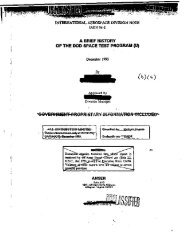LUNAR EXPEDITION PLAN
LUNAR EXPEDITION PLAN
LUNAR EXPEDITION PLAN
Create successful ePaper yourself
Turn your PDF publications into a flip-book with our unique Google optimized e-Paper software.
any unmanned BystemT It Is veil recognized that maximum reliability<br />
Is desirable, but also known that reliabilities In excess of 6$ to<br />
9056 are extremely difficult to achieve with systems as complex as<br />
the Lunar Transportation System- Therefore, the need for an abort<br />
system to protect the man during'the "unreliable" portions of the<br />
lunar mission is accepted.<br />
A review of the proposed techniques and equipments to provide a<br />
"full abort" capability has shown that due to payload limitations<br />
this is not practical during the early lunar missions. Thus a<br />
reasonable element of risk will be involved. In order to decrease<br />
this element of risk and to understand where it occurs the lunar<br />
mission has been divided Into six time-periods. These time periods<br />
are as follows: '<br />
a. Earth ascent.<br />
b. Earth-moon transit.<br />
c. Lunar terminal.<br />
d. Lunar ascent.<br />
e. Moon-earth transit.<br />
f. Re-entry.<br />
The development and test philosophy for 'this program Is to<br />
launch the manned systems as early as possible in the program, but<br />
in an unmanned status. This will provide experience and allow the<br />
system to be checked out and "man-rated" before the first manned<br />
flight. It also means that the lunex Be-entry Vehicle will be used<br />
for orbital and clrcumlunar flights prior to the lunar landing and<br />
return flight. The propulsion systems used for these early flights<br />
will be used throughout the program and the experience gained from<br />
each flight will increase the probability of success in reaching<br />
the final lunar landing and return objective. Also these propulsion<br />
systems will be used concurrently In other programs and<br />
at the time of man-rating vlU possess greater launch experience<br />
than can be expected for the largest booster of the Space Launching<br />
System. This would indicate that a larger number of unmanned flights<br />
should be scheduled for the larger full boost system than for the<br />
early flights. It also points out the need for a sophisticated<br />
Earth Ascent Abort capability during the first manned lunar iimfl-twg<br />
and return flight. '<br />
VDLAR-S-458<br />
Tkli tfKimil HMBhn MimwTtai •fbcHni tk* MtiMMl atfcu* «f ttw Un'rWd SMMi wllhta tat Mnf** af ft* bptoaoaa Lawi. IMa<br />
II, U.S.C-, SK)!M 7V3 and 7M, th* (rannhilM m IHIMIH «f which to an) m w M> aa HHIMad psoas ii arahJMM uw to".




